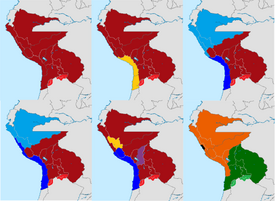Restoration Army of Peru
| Restoration Army of Peru | |
|---|---|
| Ejército Restaurador del Perú | |
 | |
| Leaders | |
| Dates of operation | 1836-1839 |
| Merged into | United Restoration Army |
| Motives | Restoration of a united Peruvian state |
| Allies | |
| Opponents | |
| Battles and wars | War of the Confederation |
The Army of the North of Peru or Restoration Army of Peru was the army of the Northern Peruvian Republic that was made up of Peruvians opposed to the establishment of the Peru-Bolivian Confederation, who accused Bolivian President Andrés de Santa Cruz of having invaded and divided Peru with the support of Peruvian President Luis José de Orbegoso whom his opponents did not recognize as legitimate. It later merged with the Chilean Army to form the United Restoration Army. The goal of the army was to restore the united Peruvian state prior to the establishment of the Confederation.[1]
The first person to use the name was General Felipe Santiago Salaverry during the war against Santa Cruz and Orbegoso. Upon his defeat and death, the command passed to Marshal Agustín Gamarra, with the title of Provisional President of the Peruvian Republic.[a][3]
Members[]
Most of the officers were chiefs deported by supporters of Andrés de Santa Cruz such as Agustín Gamarra, Ramón Castilla, Manuel Ignacio de Vivanco, Felipe Pardo y Aliaga and Antonio Gutiérrez de la Fuente, along with separatist troops from Peru such as the Huaylas Battalion and the Hunters of Peru.[1][4] Together with the Chilean Army and Navy, they formed the United Restoration Army, mentioned above. The organization of logistics, supplies and medicines for the restorers was entrusted to La Fuente.
United Restoration Army[]
| United Restoration Army | |
|---|---|
| Ejército Unido Restaurador | |
 | |
| Leaders | |
| Dates of operation | 1837-1839 |
| Motives | Restoration of a united Peruvian state |
| Allies | |
| Opponents | |
| Battles and wars | War of the Confederation |
The United Restoration Army was the military body formed in 1837 by the alliance of the land and naval forces of the Republic of Chile and the Restoration Army of Peru, formed in 1836 by Peruvian soldiers opposed to the Peru-Bolivian Confederation. Manuel Bulnes Prieto was appointed as its general in chief.[5][6]
Among its members were the North Peruvian military and politicians Antonio Gutiérrez de La Fuente and Ramón Castilla, among others, who were exiled in Chile. There were also General Manuel Ignacio de Vivanco, Andrés Martínez and the politician Felipe Pardo y Aliaga, who negotiated the deal with Chile to intervene in favor of the North-Peruvian State, joining forces in order to break the Confederation.[1] Likewise, former North Peruvian president Agustín Gamarra and his followers were also refugees, who finally formed the United Restoration Army in Chile. After the war, the military campaigns were paid by Peru to the government of Chile.[7]
Legacy[]
The defeat of the Peru-Bolivian Confederation occurred in the town of Villa de Yungay, in the Department of Huaylas on January 20, 1839.[8] In commemoration of this victory, the Department of Huaylas took the name of the Department of Ancash, as it is known today.
Later the term was used again during the Peruvian revolutions where one of the parties called restoration to the cause they defended, such was the case of the revolution led by General Mariano Ignacio Prado in 1865.[9][10]
See also[]
- War of the Confederation
- Peru–Bolivian Confederation
- North Peru
- South Peru
Notes[]
References[]
- ^ a b c Tamayo Herrera, José (1985). Nuevo Compendio de Historia del Perú. Editorial Lumen. pp. 255–256.
- ^ Placencia, Antonio (1840). Diario militar de la campaña que el Ejército Unido Restaurador abrió en el territorio peruano el año de 1838 contra el general Santa-Cruz titulado Supremo Protector de la Confederación Perú-Boliviana (in Spanish). J. Masias.
- ^ Agustín Gamarra, Presidente Provisorio de la República Peruana
- ^ "BATALLA DE YUNGAY - 20 ENERO 1839". Museo Histórico y Militar de Chile. 2014-12-29.
- ^ Villalobos Rivera, Sergio (2002). Del cerro Barón a Yungay. Chile y Perú. La historia que nos une y nos separa 1535-1883 (in Spanish). Santiago: Editorial Universitaria. p. 53. ISBN 978-956-11-1601-6.
- ^ Documentos relativos a reclamos al gobierno del Perú sobre propiedades britanicas tomadas por autoridades peruanas, desde 1835 hasta 1839. Peru. 1840. pp. 72–73.
- ^ Convención celebrada con el gobierno de Chile para el pago de la deuda peruana, de 11 de diciembre de 1849 (PDF). 1849. Archived from the original on 2007-09-27.
- ^ Varas, José Antonio (1870). Recopilacion de leyes i decretos supremos concernientes al ejército, desde abril de 1812 a [diciembre de 1887] ...: Abril de 1812 a abril de 1839 (in Spanish). Santiago: Imprenta nacional. pp. 520–521.
- ^ Dávalos y Lissón, Pedro (1926). "XIII: San Román y Pezet". La primera centuria: causas geográficas, políticas y económicas que han detenido el progreso moral y material del Perú en el primer siglo de su vida independiente (in Spanish). Vol. IV: Causas políticas y económicas. Lima: Librería e Imprenta Gil. p. 143.
- ^ Peralta Ruiz, Victor (2018). Guerra internacional, revolución y dictadura: los partidos parlamentarios y la política peruana entre 1865 y 1867 [International War, Revolution, and Dictatorship: Parliamentary Parties and Peruvian Politics between 1865-1867] (in Spanish). Pontificia Universidad Católica del Perú. p. 97.
- Military history of Peru
